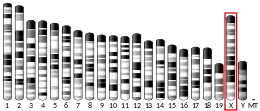Shroom family member 2 is a protein that in humans is encoded by the SHROOM2 gene. [5]
Function
This gene represents the human homolog of Xenopus laevis apical protein (APX) gene, which is implicated in amiloride-sensitive sodium channel activity. It is expressed in endothelial cells and facilitates the formation of a contractile network within endothelial cells.
Depletion of this gene results in an increase in endothelial sprouting, migration, and angiogenesis. This gene is highly expressed in the retina, and is a strong candidate for ocular albinism type 1 syndrome. Alternatively spliced transcript variants have been found for this gene. [provided by RefSeq, Mar 2016].
References
- 1 2 3 GRCh38: Ensembl release 89: ENSG00000146950 - Ensembl, May 2017
- 1 2 3 GRCm38: Ensembl release 89: ENSMUSG00000045180 - Ensembl, May 2017
- ↑ "Human PubMed Reference:". National Center for Biotechnology Information, U.S. National Library of Medicine.
- ↑ "Mouse PubMed Reference:". National Center for Biotechnology Information, U.S. National Library of Medicine.
- ↑ "Entrez Gene: Shroom family member 2". Retrieved 2017-11-05.
Further reading
- Farber MJ, Rizaldy R, Hildebrand JD (2011). "Shroom2 regulates contractility to control endothelial morphogenesis". Mol. Biol. Cell. 22 (6): 795–805. doi:10.1091/mbc.E10-06-0505. PMC 3057704. PMID 21248203.
This article incorporates text from the United States National Library of Medicine, which is in the public domain.



